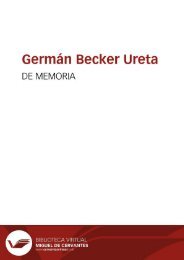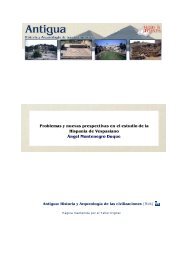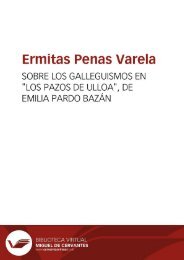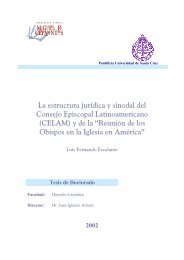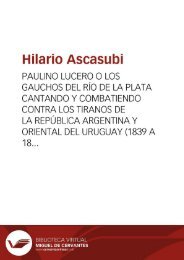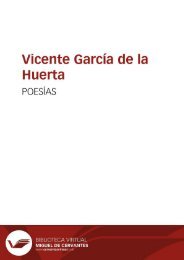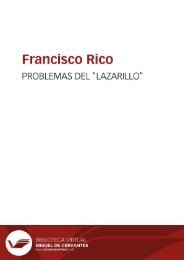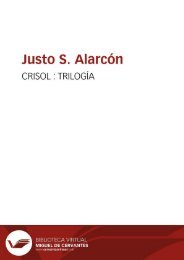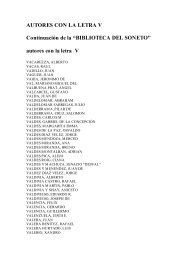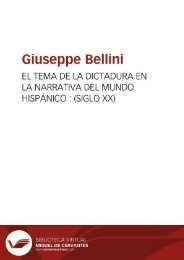Create successful ePaper yourself
Turn your PDF publications into a flip-book with our unique Google optimized e-Paper software.
Anales galdosianos [Publicaciones periódicas]. Año XII, 1977<br />
The other perspective sets a value on the subject of fiction. « Yo no existo » is a flagrant declaration<br />
of Máximo's fictionality. The words are immediately corroborated: « Soy una condensación artística .<br />
Quimera soy, sueño de sueño y sombra de sombra, sospecha de una posibilidad » (I, 1-2). But<br />
paradoxically, the cry of « Yo no existo » can be uttered only by a being existentially aware of<br />
himself. « Yo no existo », which says «I am a fiction, a dream», means «I exist». It is as much an<br />
averment of existence -more so perhaps- as Augusto Pérez's climactic « Yo soy yo ». When the<br />
second chapter proclaims, « Yo soy Máximo Manso », that then needs to be read as «I do not exist».<br />
More accurately, the statement says: «I exist because I do not exist». The passage from « Yo no<br />
existo » to « Yo soy Máximo Manso » is the affirmation of non-existence, that is, the apotheosis of<br />
fictionality. Manso's opening protest against any possible investiture « de los inequívocos atributos<br />
de la existencia real » must be taken literally. Later the text is dotted with efforts to project onto the<br />
reader Máximo's intuition of his fictional otherness: « Me veía como figura de pesadilla, o como si yo<br />
fuera otro y con ese otro estuviera soñando en la plácida quietud de mi cama » (XIX, 116). Midway<br />
into the novel, Manuel Peña characterizes Manso to his face with words that most analysts of El<br />
amigo Manso feel constrained to quote: « -Usted no vive en el mundo, maestro Su sombra de usted<br />
se pasea por el salón de Manso; pero usted permanece en la grandiosa Babia del pensamiento, donde<br />
todo es ontológico, donde el hombre es un ser incorpóreo, sin sangre ni nervios, más hijo de la idea que<br />
de la historia y de la Naturaleza; un ser que no tiene edad, ni patria, ni padres, ni novia » (XX, 124).<br />
The meaning of these words in the context of Manolo's thought/action, theories/deeds, ontology/fife<br />
dichotomy is clear. They are, beyond that, the novel's most explicit internal link with its frame. What<br />
Manolo takes to be a character portrayal of his teacher is a description of his fictional essence that<br />
matches his self-appraisal. The play here is complex: <strong>Galdós</strong>' autonomized creation's autonomized<br />
creation recreates his creator coincidentally with the latter's self-creation. What I am saying -what<br />
<strong>Galdós</strong> is saying- is that Máximo Manso exists because he is a fiction, just as Unamuno exists not<br />
because he wrote Niebla but because he is a character in Niebla . Máximo as a non-existent entity<br />
acquires an existence that he could not otherwise have. Living in the bourgeois social atmosphere of<br />
Restoration Spain, Máximo as a man, even as a thinking man, is part of it; but as a fictional creature<br />
he transcends it. He exists in space and time in a way that Castelar's mother or <strong>Galdós</strong>' third brother<br />
-or <strong>Galdós</strong> himself- do not.<br />
Once his fictive autonomy is certified, Máximo can say: « Es que alguien me evoca, y por no<br />
sé qué sutiles artes me pone como un forro corporal y hace de mi un remedo o máscara de persona<br />
viviente » (1, 2). Máximo's friend who evokes him -suppose, if you wish, that his name is Pérez<br />
96



